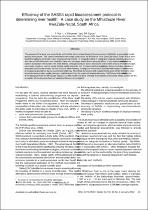 ResearchSpace
ResearchSpace
Efficiency of the SASS4 rapid bioassessment protocol in determining river health: A case study on the Mhlathuze River, KwaZulu-Natal, South Africa
JavaScript is disabled for your browser. Some features of this site may not work without it.
- ResearchSpace
- →
- Research Publications/Outputs
- →
- Journal Articles
- →
- View Item
| dc.contributor.author |
Vos, P

|
en_US |
| dc.contributor.author |
Wepener, V

|
en_US |
| dc.contributor.author |
Cyrus, DP

|
en_US |
| dc.date.accessioned | 2007-03-14T06:47:10Z | en_US |
| dc.date.accessioned | 2007-06-07T10:08:50Z | |
| dc.date.available | 2007-03-14T06:47:10Z | en_US |
| dc.date.available | 2007-06-07T10:08:50Z | |
| dc.date.issued | 2002-01 | en_US |
| dc.identifier.citation | Vos, P, et al.2002. Efficiency of the SASS4 rapid bioassessment protocol in determining river health: A case study on the Mhlathuze River, KwaZulu-Natal, South Africa. Water SA, vol. 28(1), pp 13-22 | en_US |
| dc.identifier.issn | 0378-4738 | en_US |
| dc.identifier.uri | http://hdl.handle.net/10204/1886 | en_US |
| dc.identifier.uri | http://hdl.handle.net/10204/1886 | |
| dc.description.abstract | The purpose of the study was to verify the ability of the South African Scoring System version 4 (SASS4), to assess the health of aquatic ecosystems. The macro invertebrate community attributes of the Mhlathuze River (KwaZulu-Natal, South Africa) were studied by applying the SASS4 rapid bioassessment method. In testing the effect of spatial and temporal variability in community structure on SASS4 scores it was found that there was a stronger spatial than a temporal effect. It was determined that of the indices used in association with SASS4, the biotic indices (average score per taxon, total score and number of tax) reflected changes in community structure, but the abiotic habitat quality index did not. It was found that qualitative family-level data provided an adequate classification of sites for use in routine biomonitoring. Ambiguous results were obtained with respect to the importance of measuring abundance during routine biomonitoring. No definite conclusion with respect to the ability of the SASS4 to reflect physical-chemical water quality changes could be drawn from the results obtained in this study. SASS4 was able to reflect the effect of the tidal push from the Mhlathuze Estuary, but this marine influence probably masked less pronounced effects exerted by the remainder of the physical-chemical variables that were investigated. | en_US |
| dc.format.extent | 1568553 bytes | en_US |
| dc.format.mimetype | application/pdf | en_US |
| dc.language.iso | en | en_US |
| dc.publisher | Water Research Commission | en_US |
| dc.rights | Copyright: 2002 Water Research Commission | en_US |
| dc.subject | Bioassessments | en_US |
| dc.subject | SASS4 | en_US |
| dc.subject | Mhlathuze river | en_US |
| dc.subject | KwaZulu Natal | en_US |
| dc.subject | South Africa | en_US |
| dc.subject | Aquatic ecosystems | en_US |
| dc.title | Efficiency of the SASS4 rapid bioassessment protocol in determining river health: A case study on the Mhlathuze River, KwaZulu-Natal, South Africa | en_US |
| dc.type | Article | en_US |
| dc.identifier.apacitation | Vos, P., Wepener, V., & Cyrus, D. (2002). Efficiency of the SASS4 rapid bioassessment protocol in determining river health: A case study on the Mhlathuze River, KwaZulu-Natal, South Africa. http://hdl.handle.net/10204/1886 | en_ZA |
| dc.identifier.chicagocitation | Vos, P, V Wepener, and DP Cyrus "Efficiency of the SASS4 rapid bioassessment protocol in determining river health: A case study on the Mhlathuze River, KwaZulu-Natal, South Africa." (2002) http://hdl.handle.net/10204/1886 | en_ZA |
| dc.identifier.vancouvercitation | Vos P, Wepener V, Cyrus D. Efficiency of the SASS4 rapid bioassessment protocol in determining river health: A case study on the Mhlathuze River, KwaZulu-Natal, South Africa. 2002; http://hdl.handle.net/10204/1886. | en_ZA |
| dc.identifier.ris | TY - Article AU - Vos, P AU - Wepener, V AU - Cyrus, DP AB - The purpose of the study was to verify the ability of the South African Scoring System version 4 (SASS4), to assess the health of aquatic ecosystems. The macro invertebrate community attributes of the Mhlathuze River (KwaZulu-Natal, South Africa) were studied by applying the SASS4 rapid bioassessment method. In testing the effect of spatial and temporal variability in community structure on SASS4 scores it was found that there was a stronger spatial than a temporal effect. It was determined that of the indices used in association with SASS4, the biotic indices (average score per taxon, total score and number of tax) reflected changes in community structure, but the abiotic habitat quality index did not. It was found that qualitative family-level data provided an adequate classification of sites for use in routine biomonitoring. Ambiguous results were obtained with respect to the importance of measuring abundance during routine biomonitoring. No definite conclusion with respect to the ability of the SASS4 to reflect physical-chemical water quality changes could be drawn from the results obtained in this study. SASS4 was able to reflect the effect of the tidal push from the Mhlathuze Estuary, but this marine influence probably masked less pronounced effects exerted by the remainder of the physical-chemical variables that were investigated. DA - 2002-01 DB - ResearchSpace DP - CSIR KW - Bioassessments KW - SASS4 KW - Mhlathuze river KW - KwaZulu Natal KW - South Africa KW - Aquatic ecosystems LK - https://researchspace.csir.co.za PY - 2002 SM - 0378-4738 T1 - Efficiency of the SASS4 rapid bioassessment protocol in determining river health: A case study on the Mhlathuze River, KwaZulu-Natal, South Africa TI - Efficiency of the SASS4 rapid bioassessment protocol in determining river health: A case study on the Mhlathuze River, KwaZulu-Natal, South Africa UR - http://hdl.handle.net/10204/1886 ER - | en_ZA |





